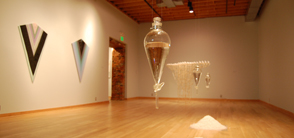POLIPOP, Mina Cheon at Maryland Art Place, May 3 ‘12
By Irina Aristarkhova, Artist Organized Art | April 23, 2012
I fully surrender to Mina Cheon’s ability to control the “poster aesthetic,” with its beautiful clarity and shamelessness of propaganda. Writing here, therefore, is not a form of resistance, but rather, of surrender. From Cheon one can learn the attraction of contemporary art, with its strategic use of materials (one uses what is necessary, rather than a default medium) and therefore, its puzzle. As an artist who employs a variety of resources at her disposal, from research and performance to new media and painting, Cheon complicates for me the idea of “good”: good ideology, good aesthetic, good technology, and good sexuality. By not representing too neatly the divisions between “evil ideology” and “evil technology” versus “good community” and “good humanity,” Cheon refuses the latent or obvious technophobia. The artist mixes women and machines with a precision of a surgeon. This nexus is not a simple embrace of technology, however. It is a strategy of joining forces between those who have been denied full humanity – women and machines. Once again, flipping the stereotypical images through spotlighting them, Cheon draws on their power to reinforce her own message. The two-three color background is identifiably militaristic and fetishistic, but at the same time, archaic in its appeal to an ethnic tradition and spirituality (fully red, fully green, etc.). The artist spices up her aesthetic with a healthy dose of gender politics, making her images almost unbearable in how closely they follow the canon of gender stereotypes. Women, flowers, tanks, missiles, dragons, larger than life faces of political leaders, gadgets, – this is the imagery of the new generation. The question that comes to mind, looking at these incredible works: “Do these images mean anything anymore?” Maybe, we are in a virtual reality game?
This work, seemingly loud and clear, requires silence and contemplation. Looking at them longer, I start feeling for Cheon’s characters. The empathy that her work evokes deconstructs the notions of simulacra and digital delirium. Empathizing with these works made me recollect how I observed Jean Baudrillard, the famous author of Simulacra and Simulation, and his wife on their visit to Seoul almost ten years ago. He was giving a talk at Ewha Woman’s University (part of the Media_City_Seoul Biennial, 2002, also where Cheon did her visiting professorship in 2011 as well as it being her alma mater). A high-tech country, as developed as France, but still feeling and being treated like an underdeveloped, as Cheon’s images demonstrate. The thinker seemed totally absorbed in himself, sitting alone on stage, reading his lecture on the topic of media and technology, without raising his head. A spotlight was on him, as if we were in a theatre, where one actor, the only actor, was reading his lines. A somber, dark, picture, of media and technology, which Baudrillard painted till the end. His wife sat in the front row, wearing high heels, elegant, tall (compared to those around her),and took many photographs with her small camera, directly shooting at our faces, pointing her camera into our faces, and looking as if being in wonder where she was. After the lecture ‘Korean girls’ (just like in Cheon’s posters? As well as those she is familiar with having gone to school in Seoul during various grades growing up whether they are actual girls or those who are imagined or projected) were screaming and asking for autographs as the Baudrillards passed by. They were photographing him at a close range, while his wife was photographing them photographing him. Baudrillard was performing ‘Pamela Anderson’ that evening, a star on a global circuit. Is there a difference, as far as the underlying aesthetic is concerned? This was, after all, the question raised in his own writings. Baudrillard looked intimidated, and probably, tired from the jetlag, shocked at the amount of technology and gadgets that people did not feel shy to use openly and a lot. Did he feel empathy? Cheon’s work, despite of being so direct and in my face, like those cameras, makes me co-feel, makes me feel compassion for her characters, who also often happen to be pop- or political stars. One can only wonder, what Baudrillard knew about South Korea before making that trip, and what kind of research he did about the country, the University, and those ‘Korean girls’ he came to speak to. As Cheon’s work also demonstrates, however, all those taken images could become one huge mess -a pile of representation, information, a confirmation of the evils of our mediated, twenty-four-seven, global simulacrum. And it is empathy for and politics of sexual, racial, and cultural differences, and not only technology of or desire for these differences that is so remarkable about Cheon’s representational choices.
Mina Cheon is also your typical superwoman: scholar, professor, mother, wife, artist, friend… Should I say more? Her contributions to the general area of new media art and theory are unique, evidenced by the book Shamanism + Cyberspace (2009). Cheon’s art is spellbinding. These art works are an injection of the most irresistible blend: ideology, aesthetics, technology, and sexuality. Born in the USSR, I am particularly susceptible to this blend, and I am not going to resist it. After all, I did assemble my toy MIGs (plastic models of Soviet supersonic jets) and proudly displayed them on my piano as a teenager. This global quality of “superwomanness” that Cheon represents for us here is, however, not what we usually think. As we grow out of our teenage years, we realize that the superwomanness is not about flying faster than the speed of light, or spinning ourselves to turn into cyborgs. With the full power and confidence of a superwoman, Cheon flips the technological into political. Or, as she demonstrates through an image of the existing sisterhood between a North Korean woman and a South Korean woman, the technological has never been a part of the superwomanness for a woman. Apparently, for a woman, to qualify as a superwoman in the 21st century, she has to spin, spin, spin, and then (one, two, three…), turn into being: “1. beautiful; 2. smart; 3. modest; 4. devoted wife; 5. bring income; 6. make babies; 7. educate self & children; 8. keep household; 9. book keeping; 10. good to in-laws; 11. take care of elders; 12. faithful to country and people; 13. know how to make kimchi from scratch; 14. good in bed while being a virgin” (as stated in Cheon’s Polipop digital painting Superwoman Complex). Nowhere here does it say “restoring justice around the world,” “inventing a time machine” or, at the very least, “assembling supersonic jets.” This image of sisterhood, between an icon of the communist state, portrayed in her stereotypical pop cultural fashion (the green “sexy” military uniform), and a middle class woman of capitalism, portrayed in a supposedly positive stereotypical image of the professional suit (of a flight attendant, or some other kind of business assistant, perhaps?), is laughable. This is where I salute Cheon’s ability to make me laugh, rather than become angry or sad. I cannot make kimchi from scratch, but surely, I can make a “real” Russian salad! What is our alternative, after all? Not to be modest (like “Pamela Anderson”?), not to be good to in-laws (like “Desperate Housewives”?), not to educate ourselves and our children (pick your own alternative to good education)? What Cheon is making us understand through this sisterly laughter, is that this list is so seductive because some parts of it are what we often want. As any good lie, it has elements of truth. This list is also powerful because becoming a ‘bad girl,’ the alter ego of the superwoman, is about following the same list, just in a reversed fashion: do not be this or that. Between a virgin and a prostitute: where is the space for my desire? Transnational dialogue here is necessary, where we can put our national flags aside and carefully examine what is at stake for us in all these lists. Mina Cheon’s work is a huge step in this direction. Cheon and Obama: We Can Do It. I LOVE IT.


.jpg)
.png)
.png)
